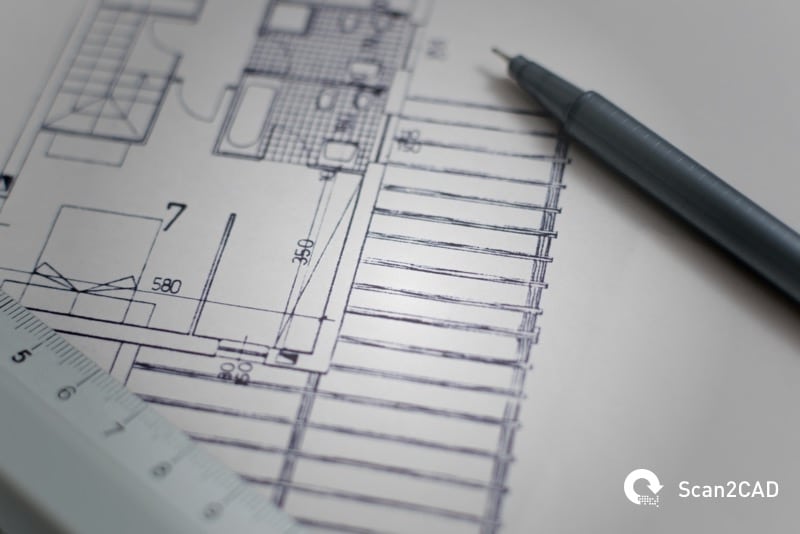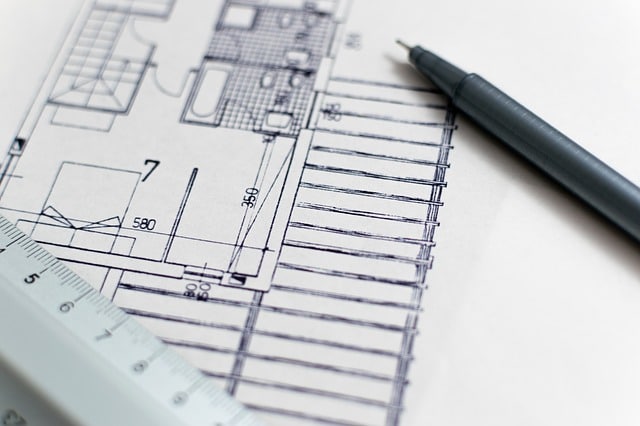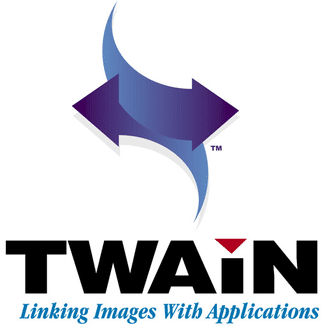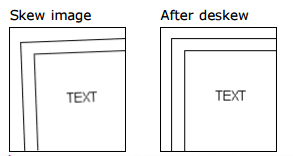How to Turn Hand Drawn House Plans Into Cad Drawings
How to Catechumen Paper Drawings for CAD

Though the medium of design has now shifted from the sketchpad to the screen, there are nonetheless those who prefer to sketch past hand. Notwithstanding, information technology'due south rare to notice anyone within the design manufacture who produces a difficult copy of a design without a digital file to dorsum it upwards. After all, newspaper drawings are just concrete records. Designers and engineers need to convert these drawings to fully editable vector designs and then they tin use them in CAD.
This guide covers everything yous need to know about scanning a design into the computer, and converting the resulting raster file into a CAD-friendly vector format.
Table of Contents
- When would paper to CAD conversion be used?
- Why practise you demand conversion software?
- Scanning your drawing
- Pre-conversion clean-up
- Converting to vector
- Post-vectorization editing
- Useful resources
When would paper to CAD conversion be used?

There are several instances where paper to CAD conversion becomes necessary.
I common scenario involves erstwhile technical drawings or architectural plans. Your studio may take won a contract to develop part of a site further. The problem is, all of the previous plans were drawn on physical paper, rather than on a program like AutoCAD. In such an instance, you could begin by manually drawing the designs in your preferred software, and going from at that place. However, this would require a huge commitment of time and free energy, which would be better spent editing the initial blueprint to the client's new specifications. A more efficient method would exist to use the technological advances that are present in Scan2CAD, which allow you to automatically convert a scanned paper drawing to a CAD format.
The same principle applies to hand-drawn sketches, or any other design that has been produced on paper.
Why do you need conversion software?
When yous browse your drawing—either onto your computer, or directly into Scan2CAD—yous will be able to save it as a raster file. Raster file formats are commonly used brandish on the web, simply are not suitable for use within the context of CAD design. Their lack of structure means that you cannot edit individual entities without affecting the image as a whole. Furthermore, if you increase the paradigm size, this can cause the drawing to lose quality and appear fuzzy or pixelated.
In order to use your scanned paper drawings for CAD pattern purposes, you volition need to catechumen them into a CAD-compatible vector format, such every bit DXF (Drawing Etenchange Format) or DWG (Drawing). Unlike raster images, vector files are capable of property masses of data almost each private chemical element. This information is readable by CAD software, and is invaluable when collaborating on an important project.
Vectors also benefit from resolution independence: however far you zoom into the file, you volition never see a loss of quality. Furthermore, whereas raster graphics are made up of pixels, vector graphics are made up of objects, such every bit lines, arcs, Bezier curves or polygons. You can edit each of these entities individually without affecting the remainder of the image, granting the designer much more liberty.
At that place are 2 methods of vectorization: manual tracing and automated tracing. The term 'tracing' refers to the procedure of drawing over raster images with vectors. While humans can empathise blueprint more than effectively than engineering science, we're more prone to inaccuracy. Tracing past hand with a graphics stylus or mouse is also very time consuming. Automatic tracing, on the other hand, is performed past raster-to-vector software like Scan2CAD. You lot may have to touch-upward raster images prior to conversion, but the process is very quick: information technology takes mere seconds.
With Scan2CAD, you tin can opt to convert a scanned drawing to a wide range of unlike vector formats—most commonly DXF or DWG. We'll await at the differences betwixt the two, and how to vectorize your drawing a trivial after.
Scanning your drawing
Can you scan any cartoon?
Conversion software is only able to work with what it's given. When assessing whether your drawing is suitable for scanning, you need to be aware of both size and clarity.
Some drawings are simply as well small to be scanned, still much y'all try to offset this with resolution. Others are too faint, or too dirty, to be cleaned up well enough to produce a apparent browse. You also need to be aware of obscured lines. If likewise many lines are overlapped by text, no software would exist able to make sense of the information.
What type of scanner can yous utilize?
Y'all can scan directly to Scan2CAD: all you need is a compatible scanner. These include any Twain- or WIA-compliant scanner, or, if you lot have the pro version, a Colortrac SmartLF scanner, or an HP Designjet T2300 eMFP.
Simply beginning by loading your design directly from your scanner into Scan2CAD. If a dialogue box appears, choose appropriate settings, and then instruct the software to Scan.
It makes little divergence which of these scanners is used, although the latter model does offer you lot a preview within the software; utilize this to bank check whether your scan is fit for conversion. If not—if your drawing is skewed, for example—rescan until the prototype is optimal.
If you don't accept access to any of the scanners mentioned, yous tin can however convert your drawing to CAD: it will just add a couple of actress steps. Just browse your drawing onto your computer as normal, load it in Scan2CAD, and vectorize.
When scanning your drawing, it's of import to save it as a lossless format. TIFF is an platonic format; other lossless formats include BMP and PNG. You should avertlossy formats, such as JPEG, which sacrifice image quality for smaller file sizes.
Scanner Settings
Color
Well-nigh scanners give you the option to browse in color, grayscale, or monochrome. In well-nigh cases, the all-time option for vectorization is to browse your cartoon inmonochrome. This separates your prototype into just two colors—blackness and white—which means that Scan2CAD can hands dissever out the blueprint in the foreground from the white background.
If scanning an epitome as a monochrome paradigm, it's worth checking your scanner'souththreshold settings. These determine which parts of your image are scanned as black and white respectively. If they're ready too high, text may "bleed", and speckles may appear in the groundwork. Fix them too depression, and your paradigm may lack particular. It's possible, notwithstanding, to just scan your paradigm ingrayscale, then separate the colors out into black and white using Scan2CAD'south thresholding tool.
Resolution
Loftier resolution doesn't automatically produce a improve scan; the important thing is to detect the resolution that is most appropriate. Only you should likewise be aware that while y'all tin can decrease image resolution afterward information technology has been scanned, you cannot increment it. As a general dominion, you should be looking at a resolution between 200 and 400 DPI; smaller images, such as logos, may require higher resolution. If your scan appears pixelated, this is a key sign that you need to increment the resolution. Likewise with characters within areas of text, and the spacing of entities—you lot want clear white space to be visible between them.
This latter issue may need a combination of resolution and threshold adjustments, and you should experiment with both until the image is optimal.
Pre-conversion clean-up

Using the Deskew tool on very skewed images usually results in a significant loss of quality
Earlier converting your raster scan to a vector file, ensure that y'all accept not missed any bones errors. Check that the whole drawing has been scanned and that it is every bit straight equally possible. While Scan2CAD does provide a deskew tool, using it may result in a loss of quality. See our comprehensive guide for optimal raster-to-vector conversion results for more than areas you should watch out for.
If you practice need to make clean up any of the epitome, there are a number of tools bachelor to you. Other than deskew, you can as well fill in missing gaps in lines. Apply the Remove Holes function for pocket-sized holes, or Inundation Make full for larger gaps. Opting to Smoothen lines will become rid of stray 'hairs' from your lines, and if in that location is a pocket-size amount of dirt in the groundwork, you can 'Remove Speckles' to eliminate marks.
It'southward best at this point to work through the full quality checklist, zooming in to ensure y'all haven't missed anything that will become an upshot during vectorization.
Converting to vector
DXF or DWG?
To convert from a simple image to a file that contains important design data and that can be easily edited in CAD software, you'll need to convert your drawing from raster to vector. With Scan2CAD, you tin can choose between numerous vector formats, notably including DXF or DWG. Both formats let you to edit individual entities and reuse them, should y'all so wish. This can relieve fourth dimension in the hereafter when creating CAD files with similar elements to those in this file. What'south more, neither DXF or DWG files are resolution dependent: however far y'all zoom in or out; whatever size you view the image, the cartoon's quality volition be retained.
But while DXF files are supported almost universally by CAD programs, making them ideal for collaboration, the DWG format is native to AutoCAD. If y'all don't own this software, don't panic—you may still be able to view and edit a DWG without AutoCAD.
You may prefer this format if you are bang-up to edit the drawing using native AutoCAD entities, or if yous are only going to be sharing the file with those who use the same software. If you are unsure which to go for, take a closer look at the qualities of each of these vector file types. And remember, it's non the cease of the world if y'all go information technology 'wrong': you lot can always convert your DWG to a DXF, or vice versa, at a later appointment.
How to vectorize your drawing
Whether you're looking to convert your scan from a TIFF or a PDF, and to a DXF or DWG, the procedure is the same.
- In one case you lot've loaded the file into Scan2CAD, you need to select Type to bring upwards different options. Choosing the correct type of drawing, such as sketch, or contour map, will ensure that the appropriate vectorization settings are applied during conversion.
- Choose which parts of the raster image y'all wish to convert, then simply click to vectorize them!
- Experiment with different settings, using the preview window provided.
- Finally, select File > Vector > Salve Every bit and choose your preferred output file format.
It really is as quick and simple as that! And, if you lot've got a mountain of hard copies that you demand to scan, there's no need to catechumen each one individually. Use the Batch Processing tool to automate the procedure, while retaining control on pre-conversion optimization.

Converting a scanned newspaper cartoon to vector using Scan2CAD
Post-vectorization editing
Once your scanned paper cartoon has been successfully converted into a format suitable for CAD, the fun has only merely begun. Make full apply of the all-encompassing vector editing suite to suit and develop the image farther, or consign the file to your favourite CAD software and work on it from there.
Useful resource
If you need more support on converting your scan to vector, then you may find the following pages helpful:
- Converting from TIFF to DXF — Your ultimate guide
- Ultimate Guide: TIFF to DWG Conversion
- Ultimate Guide: PDF to DXF Conversion
- Ultimate Guide: PDF to DWG Conversion
- FAQs: DXF Conversion
If yous want to have a become at converting a newspaper cartoon to CAD without the commitment of paying, you tin can savour a no-strings-attached, xiv-day trial of Scan2CAD without spending a penny. You'll before long realize why it is the ultimate market-leading vectorization software.
Source: https://www.scan2cad.com/blog/cad/convert-paper-drawings-cad/
0 Response to "How to Turn Hand Drawn House Plans Into Cad Drawings"
Enregistrer un commentaire